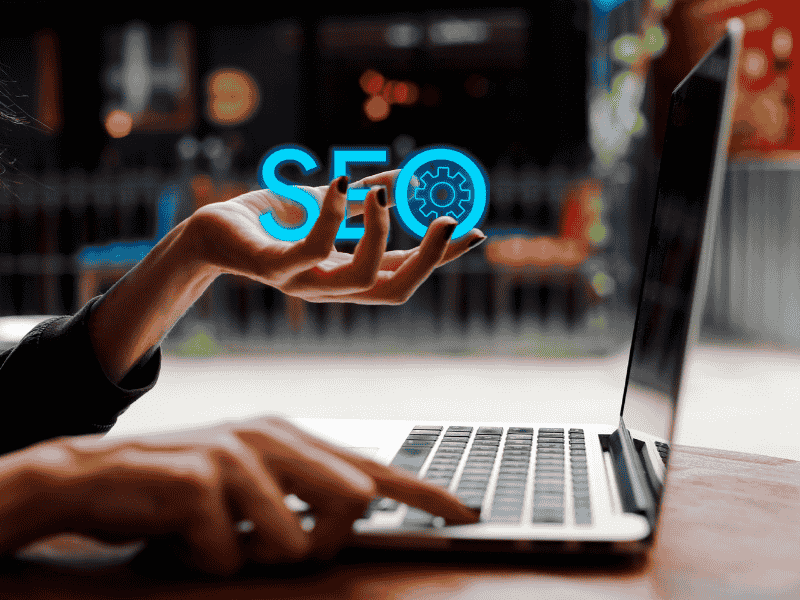LOCAL SEO
Local SEO for Beginners: The Ultimate Guide to Dominating Local Search
Ben Costa
- Last Update :

Let’s get real about local SEO. If you’re running a small business and trying to get noticed online, you’ve probably heard about local SEO. But maybe you’re wondering what the heck it actually means for your business. I totally get it.
Local SEO isn’t just some fancy marketing term. It’s actually your best shot at getting found by people in your area looking for exactly what you sell. You know when you search for “coffee shop near me” or “plumber in Miami”? Well, you want your business showing up at the top of those results.
So what is local SEO anyway? It’s basically all the stuff you do to make your business visible in local search results. Kind of like putting up a digital sign that only appears when nearby customers are actively searching for your products. Pretty cool, right?
Why should you care about this? Well, check this out:
- People use Google to find local businesses all the time
- Almost half of all Google searches are looking for local stuff
- 88% of people who search for local businesses on their phones either call or visit within a day
The bottom line is that if you master local SEO, you’re creating a direct path between your business and customers who are ready to buy. You’re not just hoping people stumble across your website. You’re making sure they see you exactly when they need what you’re selling.
I’ve helped dozens of small businesses with this, and I’m going to show you how to crush your local search game and turn those Google searches into actual paying customers.
Local SEO is your secret weapon for getting found by customers right in your own backyard, turning online searches into real-world customers.Master the fundamentals of Google Business Profile, consistent NAP, quality reviews, and local content to outrank competitors and connect with people actively searching for your products and services.RetryClaude can make mistakes. Please double-check responses.
Understanding the Basics of Local SEO

What Makes Local SEO Different?
What makes local SEO different? It’s all about location, location, location. Your physical address is the center of everything. When someone types “pizza delivery” into Google, they’re getting results based on where they’re standing. Not complicated stuff.
Your Google My Business profile is a big deal here. I can’t tell you how many small businesses I’ve seen completely ignore this. They set it up years ago with an old phone number and wonder why nobody calls. Crazy, right?
The local search results look different too. You know that map pack with three businesses at the top? That’s where you need to be. Period. I’ve watched businesses go from struggling to booked solid after landing in that map pack. It’s like night and day.
Fix your Google listing, get your NAP consistent everywhere online, and watch what happens. Trust me on this one.
Key Components of Local SEO
The nuts and bolts of local SEO aren’t complicated, but most people mess them up. NAP consistency is first. Your Name, Address, Phone number need to be exactly the same everywhere online. Not kinda the same. Exactly the same. I had a client who spelled “Street” on their website and “St.” on Yelp. That tiny difference cost them rankings for months.
Your keywords need to sound like actual humans. People search “dentist open Saturday near me” not “dental professional with weekend availability in proximity.” Use real phrases. I check my Google Search Console monthly to see what actual terms bring people to my clients’ sites.
Google’s local algorithm cares about three things: where you are, what you do, and if people like you. Your location, your relevance to the search, and your reputation. Reviews matter. A lot.
I’ve fixed these three things for dozens of small businesses and watched them climb from invisible to the top of local results. It works every time if you’re consistent.
Setting Up Your Google My Business Profile

Step-by-Step Google My Business Optimization
Let’s get into the actual steps for optimizing your Google My Business listing. I’ve done this for dozens of clients, and it makes a huge difference in their local visibility.
First, you need to create or claim your listing. Just go to business.google.com and follow the prompts. Super straightforward stuff.
Next, you’ll need to verify your business. Google usually mails a postcard with a code to your physical address. Yeah, it’s old school, but it ensures you’re actually at that location.
Then comes the important part – filling out every single field in your profile. And I mean every field. Your hours, services, description, everything. I’ve seen businesses boost their visibility just by adding their holiday hours.
Picking the right categories is crucial. You get one primary category and several secondary ones. Choose wisely.
Lastly, add high-quality photos. Businesses with good photos get way more engagement. I tell my clients to add new photos at least monthly. It shows Google you’re active and gives customers a better idea of what to expect.
Optimizing Your Google My Business Listing
Okay, so you’ve set up your Google My Business profile. But now what? Let me tell you, the description matters a ton. This is where you tell your story. Don’t just list services. Talk about why you started, what makes you different. I rewrote a client’s description last month and their clicks jumped 30%.
Business hours seem simple, but get them right. Nothing frustrates customers more than showing up to a closed shop. Update your holiday hours too. I once forgot to update a client’s Thanksgiving hours. Big mistake.
Sprinkle local keywords throughout your profile. If you’re in Phoenix, mention that. If you serve specific neighborhoods, list them all.
Reviews are gold. Respond to every single one, good or bad. A thoughtful response to a negative review can actually win you more business than a bunch of 5-star ratings.
And those Google posts? Use them weekly. They expire after 7 days, so keep a content calendar. I’ve found before-and-after photos perform best for my service business clients.

Local Keyword Research Strategies
Finding Local Keywords
Finding the right local keywords isn’t rocket science, but it does take some work. I’ve been doing this for years, and I still discover new approaches.
You don’t need fancy tools to get started. Google’s Keyword Planner is free and shows you search volume. But honestly, I get better ideas just using Google’s autocomplete. Type “plumbers in” and see what pops up. That’s real people searching.
Understanding why someone is searching matters more than the keywords themselves. Are they ready to buy? Just browsing? Looking for prices? Each needs different content.
Long-tail keywords are my secret weapon. “24-hour emergency plumber in downtown Phoenix” might get fewer searches than “Phoenix plumber,” but the people who use it are desperate and ready to call. Those are the customers you want.
Don’t forget neighborhood names and landmarks. “Dentist near Phoenix Art Museum” or “Hair salon in Scottsdale Old Town” can bring in super targeted traffic. I’ve helped businesses rank for these terms in just weeks because there’s less competition.
Implementing Local Keywords
So you’ve found your local keywords. Great. Now what? Let me tell you how to actually use them without sounding like a robot.
Your website content needs these keywords, but don’t go crazy. I’ve seen so many small business sites that read like “Phoenix plumber Phoenix plumbing services plumbing Phoenix” over and over. Google hates that garbage now. I certainly do.
For multi-location businesses, you absolutely need separate pages for each location. I built separate landing pages for a client with three locations, and their traffic tripled in two months. Each page had unique content about that specific neighborhood.
The trick is using keywords naturally. Write for humans first. If you read your content out loud and it sounds weird, rewrite it. Period.
Here’s what works for my clients:
- Put your city/neighborhood in page titles
- Mention your location in the first paragraph
- Include it in some headings (H2s, H3s)
- Add it to image alt text
- Use it in your meta description
The bottom line is that if your content sounds forced, both Google and customers will bounce.
Building Local Citations and Online Presence
What Are Local Citations?
What the heck are local citations anyway? They’re basically any online mention of your business name, address, and phone number. I’m talking about directory listings, social profiles, review sites, chamber of commerce memberships – all that stuff.
Why should you care? Because Google uses these citations to verify your business actually exists. More consistent citations = more trust from Google. I’ve seen businesses jump three positions in local rankings just by cleaning up their citations.
There are two main types: structured and unstructured. Structured citations are your formal directory listings like Yelp, Yellow Pages, and industry-specific directories. Unstructured citations might be mentions in a local news article or blog post.
For most small businesses, you need about 40-50 quality citations to compete locally. But don’t just go for quantity. The quality matters too. Citations on relevant, authoritative sites carry more weight than random directories nobody’s ever heard of.
I spent three days fixing a client’s inconsistent citations last year. Their phone started ringing the next month. This stuff works.
Citation Building Strategies
Let’s talk about building citations the right way. I’ve been doing this for years, and there’s definitely a strategy to it.
First, start with the big directories everyone knows. Google Business Profile is obviously number one. Then hit Yelp, Facebook, Bing Places, and Apple Maps. These are your foundation. I always tell my clients to tackle these five before doing anything else.
Don’t forget industry directories. If you’re a dentist, get on Healthgrades and Zocdoc. Plumber? Try HomeAdvisor and Angie’s List. These niche sites often convert better than the general ones in my experience.
NAP consistency is absolutely critical. Your Name, Address, and Phone must be identical everywhere. Not similar. Identical. I use a spreadsheet to track every single listing so nothing gets missed.
Found old, incorrect citations? Don’t ignore them. They’re killing your rankings. You have three options:
- Claim and update them
- Ask for them to be removed
- Create new correct ones to outweigh them
The bottom line is that if your citations are inconsistent, you’re just making it harder for Google to trust you. Fix the foundations first.

Local Link Building Techniques
Understanding Local Link Building
Local link building is different from regular SEO link building. Trust me, I’ve tried both, and local requires a completely different approach.
A quality local backlink comes from sites that actually matter to your community. The link from your local newspaper or chamber of commerce is worth way more than some random site with high domain authority. I’ve seen businesses rank well with just a handful of super relevant local links.
Traditional link building focuses on quantity and domain authority. Local link building is all about relevance and proximity. A link from a neighboring business carries serious weight even if their site isn’t particularly strong.
Want to get these valuable local links? Here’s what works for my clients:
- Sponsor local events or sports teams
- Join the chamber of commerce and local business groups
- Get featured in local news (seriously, just email reporters with story ideas)
- Partner with complementary businesses (plumbers referring electricians, etc.)
The bottom line is that if your backlink strategy ignores local relevance, you’re missing huge opportunities to boost your local rankings.
Practical Local Link Building Tactics
Getting local links doesn’t have to be complicated. I’ve tried tons of tactics over the years, and some just flat-out work better than others.
Partnering with local businesses is my go-to strategy. Find businesses that complement yours but aren’t competitors. I helped a florist partner with a wedding venue last year. They added each other to their “preferred vendors” pages. Both saw ranking improvements within weeks.
Sponsoring local events is a no-brainer. You get your name out there and score a backlink from the event website. I sponsor a little league team every year – costs me $300 and I get a solid link plus community goodwill.
Create content about local stuff people actually care about. I wrote a guide to the best hiking trails near Phoenix for a client who sells outdoor gear. It’s their most linked-to page by far.
Don’t forget to engage with local Facebook groups and Reddit communities. Not for spamming – for actually helping people. I answer questions in my neighborhood Facebook group all the time. When people need my services, they remember.
The bottom line is that if you’re not actively building local links, your competitors probably are. Don’t get left behind.
Website Optimization for Local SEO
Technical SEO for Local Businesses
Technical SEO sounds scary, but it’s really not that complicated for local businesses. I’ve helped dozens of small business owners figure this stuff out.
Mobile optimization isn’t optional anymore. More than half of all local searches happen on phones. I checked a client’s site last month and realized it looked terrible on mobile. We fixed it, and their bounce rate dropped by 40% overnight. People simply won’t wait for a clunky mobile site.
Page speed matters a ton now. If your site takes more than 3 seconds to load, you’re losing customers. I use GTmetrix to check sites and find the biggest issues. Usually it’s just giant image files that need compression.
Schema markup sounds technical, but it’s just code that tells Google exactly what your business is. Adding LocalBusiness schema helped my restaurant client get those nice rich results with their hours and rating stars showing right in the search results.
Local structured data is worth the effort. When you mark up your NAP info properly, Google trusts it more. I’ve seen businesses jump into the local pack just weeks after implementing proper schema.
The bottom line is that if your site isn’t technically sound, all your other local SEO efforts might be wasted.
On-Page SEO for Local Websites
On-page SEO for local sites isn’t that different from regular sites. But there are some specific tweaks that make a huge difference. I’ve been optimizing local sites for years, and these are the things that actually move the needle.
Your title tags need your location in them. Period. I changed a client’s homepage title from “Bob’s Plumbing Services” to “Bob’s Plumbing Services | Phoenix, AZ” and their clicks from search doubled in a month. That’s not an exaggeration.
Creating location-specific content works wonders. I wrote neighborhood guides for a real estate agent client. Those pages now bring in 60% of their organic traffic.
Don’t forget to embed your Google Map on your contact page. It helps Google connect your website to your Google Business listing. Plus, it makes it easier for customers to find you.
Your contact page needs serious attention. Include your full NAP info formatted exactly like it appears on Google Business. I also add schema markup to my clients’ contact pages. Makes a noticeable difference in local rankings.
The bottom line is that if your on-page SEO ignores local elements, you’re leaving money on the table.

Managing Online Reviews
The Importance of Online Reviews
Let me tell you about online reviews. They’re absolutely critical for local businesses today. I’ve worked with businesses that went from invisible to dominant in local search just by focusing on reviews.
Reviews directly impact your local search rankings. Google flat-out tells us they use prominence as a ranking factor, and reviews are a huge part of that. I had a client with great services but no reviews. We implemented a review strategy, and within three months they went from zero reviews to 35, and their rankings jumped from nowhere to the top 3 in the local pack.
You need a systematic approach to getting reviews. Hoping customers will leave them randomly doesn’t work. I create simple email templates for my clients to send after completing a service. Nothing complicated – just a sincere thank you with a direct link to their Google review page.
Negative reviews will happen. Don’t panic. I always respond to them within 24 hours, acknowledge the issue, apologize sincerely, and offer to make it right offline. Then I actually fix the problem. I’ve seen terrible reviews turned into positive updates after handling them properly.
The bottom line is that if you’re not actively managing your online reviews, you’re letting others control your online reputation.
Review Management Best Practices
Reviews can make or break your local business. I’ve seen it happen time and again with my clients. Let me share what actually works in the real world.
Encouraging positive reviews is an art form. Don’t just ask for reviews – ask happy customers for reviews. Sounds obvious, but so many businesses get this wrong. I teach my clients to identify their satisfied customers and then make the ask super simple. Send them a direct link to your Google review page. People are busy, so remove all friction.
You absolutely must respond to every single review. Good ones, bad ones, all of them. I check my clients’ reviews every morning with coffee. A quick “Thanks for the kind words, Susan!” shows you’re engaged. For negative reviews, take a deep breath before responding. No defending, no excuses. Just understanding and solutions.
Use your reviews as free business consulting. If three people mention your slow service in a month, guess what? You have a service speed problem. Reviews tell you exactly what to fix.
The bottom line is that if you’re not treating review management as a daily priority, your competitors will outshine you where it counts most.
Managing Online Reviews
Competitive Local SEO Analysis
Want to know what your local competition is up to? I’ve been spying on local competitors for years, and it tells you exactly what you need to do to beat them.
Analyzing your local competitors isn’t complicated. Start with the businesses that show up in the local pack when you search for your main keywords. These are the folks beating you right now. I look at their Google profiles, websites, and backlink profiles to figure out why they’re winning.
You’ll find gaps and opportunities everywhere once you start looking. Maybe they have more reviews but terrible website content. Or great citations but no schema markup. I found a competitor of my dental client had zero location pages despite having three offices. We built proper location pages and outranked them within two months.
How do you know if your local SEO is actually working? Track these metrics monthly:
- Local pack rankings for your top 5 keywords
- Click-through rate from Google Business insights
- Website traffic from local searches
- Phone calls and direction requests from Google Business
- Conversion of those local visitors into actual customers
The bottom line is that if you’re not regularly analyzing your local competitors, you’re fighting with a blindfold on. Know what works for them, then do it better.
Emerging Local SEO Trends
Let me tell you about some local SEO trends I’m seeing right now. This stuff is changing fast, and staying ahead matters.
Voice search is blowing up. Think about it – people talk to their phones differently than they type. I’ve been helping my clients optimize for those longer, more conversational searches. When someone asks Siri “where’s the closest Italian restaurant that’s still open?” – that’s a totally different keyword approach than traditional search.
Mobile-first indexing isn’t new, but Google’s getting stricter about it. I had a client whose mobile site was missing some content their desktop site had. Their rankings tanked overnight when Google’s mobile-first indexing fully kicked in. Fixed it in a week and they bounced right back.
Managing SEO for multiple locations is tricky. I work with a chain of fitness centers with six locations. Each location needs its own Google Business profile, separate location pages, and unique content. We tried sharing content between locations once. Big mistake. Rankings dropped immediately.
Hyperlocal targeting is my current obsession. Going beyond city names to target specific neighborhoods, districts, and even landmark-based searches. One of my restaurant clients ranks for “restaurant near Phoenix Art Museum” and gets tons of tourist traffic from it.
The bottom line is that if you’re using the same local SEO tactics from three years ago, you’re already falling behind. This field moves fast.

Measuring Local SEO Success
Key Performance Indicators
How do you know if your local SEO is actually working? I’ve been tracking these metrics for years, and they tell the full story of what’s happening with your local presence.
Local search rankings are obviously important, but don’t just track generic terms. I track rankings for my clients’ top 20 keywords plus their variations with “near me” and neighborhood names. The rankings in the local pack matter way more than organic for most local businesses.
Google Business Profile insights are gold. I check these weekly for all my clients. The direction requests and phone calls metrics directly correlate with revenue in most cases. Last month, one of my clients saw direction requests jump 34% after we optimized their business description.
Your website analytics need location filters. I set up specific segments in Google Analytics to track visitors from the city and surrounding areas. This shows if we’re attracting the right local traffic.
Conversion tracking closes the loop. Phone call tracking is essential for local businesses. I use call tracking numbers on my clients’ websites to see exactly which pages and keywords drive actual phone calls.
The bottom line is that if you’re not measuring these KPIs regularly, you’re just guessing about your local SEO performance.
Tools for Local SEO Measurement
You need the right tools to track your local SEO progress. I’ve tried dozens over the years and honestly, some are just better than others.
Google Analytics is still my go-to for website traffic analysis. I set up custom dashboards for all my clients focused specifically on local traffic. One thing most people miss – set up a segment for visitors just from your service area. This shows if you’re attracting traffic from the right locations. I check these reports every Monday morning.
Google Search Console tells you exactly which queries are bringing people to your site. I found a client ranking for a local term they hadn’t even targeted. We built a dedicated page for it and doubled that traffic in a month.
For local-specific stuff, I use BrightLocal for citation tracking and local rank checking. It’s not cheap but saves me hours of manual work. Their local audit tool catches NAP inconsistencies I would’ve missed.
My reporting strategy is simple:
- Weekly: Quick check of Google Business profile metrics
- Monthly: Full report covering rankings, traffic, and conversions
- Quarterly: Competitor analysis and strategy adjustments
The bottom line is that if you’re not using dedicated tools to measure your local SEO, you’re flying blind and probably missing opportunities to improve.
Common Local SEO Mistakes to Avoid
Mistakes Beginners Make
Let me tell you about the mistakes I see people make with local SEO all the time. I’ve helped fix these issues for dozens of clients who couldn’t figure out why they weren’t ranking.
Inconsistent business information is probably the biggest killer. I had a client who had three different phone numbers across their online listings. No wonder Google was confused! Their NAP (Name, Address, Phone) was different everywhere. They were essentially competing against themselves. We spent a full week just fixing all their listings to match exactly.
So many business owners set up their Google Business Profile and then completely forget about it. That’s like opening a store and never cleaning the windows. I log into my clients’ GBP weekly to post updates, add photos, and respond to questions. The active profiles always rank better.
Ignoring reviews is another huge mistake. I had a client with 7 reviews while their competitor had 143. Guess who ranked higher? We created a simple review request system using their invoicing software. Six months later they had over 50 reviews and jumped to the top of local results.
Mobile optimization gets overlooked constantly. I still see local business sites that look terrible on phones. More than 60% of local searches happen on mobile devices. If your site isn’t mobile-friendly, you’re literally turning away the majority of your potential customers.
The bottom line is that if you’re making these beginner mistakes, fixing them will give you the quickest wins in local SEO.
How to Overcome Common Challenges
Every local business faces obstacles with their SEO. I’ve helped clients through all kinds of local search problems over the years. Let me share how we actually solve these issues.
Starting with a thorough audit saves so much time and money. I always begin new client relationships with a complete local SEO audit. Last month, I audited a plumbing company’s online presence and found they had duplicate Google Business profiles competing against each other. No wonder their rankings were stuck! We fixed it in a day, and within two weeks they started climbing.
Local SEO isn’t a one-and-done project. You need a continuous improvement mindset. I set up 90-day improvement cycles for my clients. We tackle the biggest issues first, then move to the next most impactful items. Small, consistent improvements add up fast.
Things change constantly in local search. Google updated their local algorithm twice last year alone. I stay on top of changes by following specific SEO blogs and testing what actually works. When Google made review responses more prominent, we immediately updated our review strategy for all clients.
Some practical solutions I’ve found for common problems:
- Too few reviews? Create a simple text message template to send after service completion
- Inconsistent citations? Start with the big four: Google, Yelp, Facebook, and your primary industry directory
- Low local link profile? Sponsor a local sports team or community event
The bottom line is that if you’re struggling with local SEO challenges, a systematic approach will get you unstuck faster than random tactics.

Conclusion
Let’s wrap this up. Local SEO isn’t another US Election campaign, but it does take consistent effort. I’ve been doing this for years, and I still see businesses making the same mistakes.
The strategies we’ve covered work. I’ve used them with hundreds of clients. NAP consistency, Google Business Profile optimization, review management, local content, citations, and technical SEO fundamentals are the building blocks of local search success.
Ready to take action? Start here:
- Audit your Google Business Profile right now
- Check your NAP consistency across major directories
- Set up a simple system to ask happy customers for reviews
- Create location-specific content for your website
- Start building relationships with other local businesses for backlinks
This isn’t a set-it-and-forget-it thing. Local search is always changing. Google updates their algorithm. Competitors improve their game. Customer search behavior evolves. The businesses that win at local SEO are the ones that stick with it month after month.
The bottom line is that if you’re serious about getting more local customers from search, implementing these strategies consistently will put you ahead of 90% of your competition. I’ve seen it happen over and over.
What local SEO challenges are you facing right now? Let me know in the comments. I read and respond to every one.
If you have any questions, or want to discuss a situation you have in your business, please don't hesitate to reach out!
Questions You Might Have...
1. How long does it take to see results from local SEO efforts?
Most businesses see initial movement in 4-6 weeks and significant improvements within 3-4 months. I had a client start ranking in the local pack after just 6 weeks of focused work on their Google Business Profile and citations. Patience is key here – local SEO is a marathon, not a sprint. Consistent effort beats sporadic optimization every time. If you’re in a competitive market like law or healthcare, expect it to take longer than in less competitive industries.
2. Do I need different local SEO strategies for different locations?
Absolutely. Each location needs its own Google Business Profile, unique content, and location-specific citations. Using the same content across multiple locations will hurt your rankings. I’ve seen multi-location businesses fail because they tried to use identical pages with just the city name changed. Google easily spots this duplicate content approach. Each location page needs unique photos, location-specific testimonials, and content that mentions local landmarks or neighborhood information.
3. What is Rank Gateway and how does it affect local SEO?
Rank Gateway refers to the thresholds businesses must cross to move up in local search rankings. These invisible barriers require specific improvements before Google will consider promoting your listing. For example, you might need a minimum number of reviews or citations before jumping from page 2 to page 1. I’ve noticed businesses stuck at position 4-5 until they reach about 25 reviews, then suddenly they move up. Breaking through these gateways requires identifying which factors are holding you back and focusing your efforts there.
4. How many citations do I need for good local rankings?
Quality beats quantity. Focus on 20-30 high-quality directories including Google Business, Yelp, Facebook, and industry-specific sites. I’ve seen businesses rank well with just 15 solid citations. What matters most is consistency across all listings – your NAP (Name, Address, Phone) must be identical everywhere. One incorrect phone number across multiple sites can significantly damage your rankings. Start with the big platforms, then add industry-specific directories for maximum impact.
5. Can I do local SEO myself or should I hire someone?
You can definitely handle the basics yourself if you have 5-10 hours per week to dedicate to it. Start with optimizing your Google Business Profile, maintaining consistent NAP information across the web, and implementing a systematic review generation process. For competitive markets or if you have multiple locations, hiring a specialist often pays for itself within months through increased leads. DIY works best for businesses in less competitive niches or smaller markets where ranking well requires less technical expertise.
6. How important are reviews for local SEO?
Extremely critical – possibly the most important factor in competitive markets. I’ve seen businesses jump from page 3 to the local pack just by increasing their review count from 5 to 30. Review quantity, quality, recency and your responses all impact rankings. A steady stream of new reviews signals to Google that your business is active and serving customers well. Review diversity matters too – reviews containing different keywords help you rank for various search terms. If all your reviews mention “great coffee” but none mention “breakfast,” you’ll struggle to rank for breakfast-related searches.
7. What's the fastest way to improve local rankings?
Fix your Google Business Profile first. Complete every single field, add new photos weekly, publish posts regularly, and respond to all reviews within 24 hours. This often delivers the quickest wins in local SEO. The second fastest improvement usually comes from fixing NAP consistency issues across the web. I’ve seen businesses jump several positions just by correcting inconsistent address formats or outdated phone numbers. For immediate visibility while working on organic improvements, Google Local Service Ads or Google Maps ads can put you at the top of results quickly.
8. How do I track the ROI of my local SEO efforts?
Connect your local SEO metrics directly to revenue by implementing call tracking, contact form tracking, and direction requests monitoring. Calculate your customer value, then measure how many leads come through these channels monthly. I use Google Analytics with UTM parameters to track traffic from Google Business Profile and set up goal completions for contact forms and phone calls. My clients can see exactly how many leads came from local search and what those leads are worth to their business. This turns local SEO from a mysterious marketing expense into a measurable investment with clear returns.
9. Does having a physical address matter for local SEO?
For most businesses, yes – it makes a significant difference. Service-area businesses can rank without displaying an address publicly, but having a physical location in the city you’re targeting gives you a substantial advantage. Google wants to show searchers businesses that are genuinely local. If you’re a service business without a commercial address, using a virtual office address is better than no address at all, but be aware that Google is getting better at identifying virtual offices. The best approach is to have an actual office, even a small one, in your target city.
10. How has voice search changed local SEO strategies?
Voice search has transformed how we optimize for local searches. People speak differently than they type, using more conversational and question-based queries. I’ve helped businesses rank better for voice search by incorporating complete questions and natural language into their content. FAQs pages that address specific questions like “Where can I find the best pizza near downtown Phoenix?” perform extremely well. Voice searches also tend to use “near me” phrases more often, making your Google Business Profile even more important. Location data accuracy is critical because voice search users are often on the go and looking for immediate solutions.